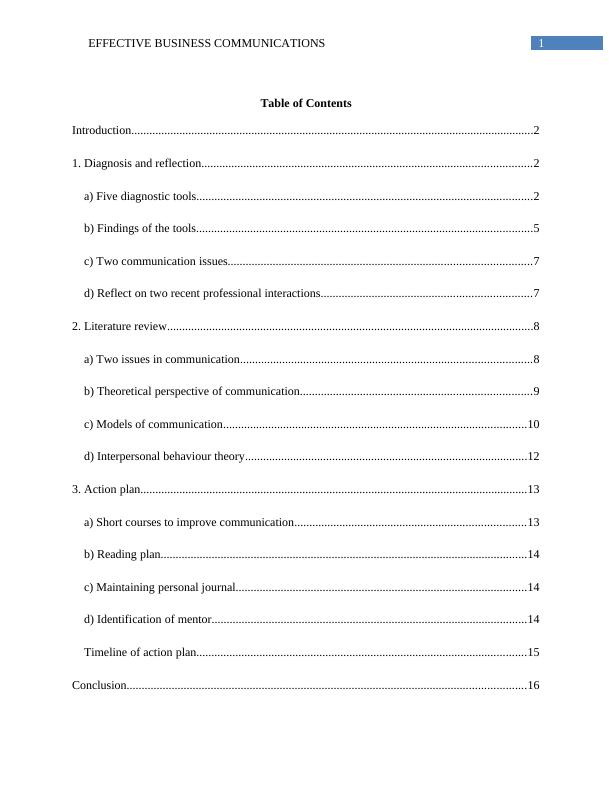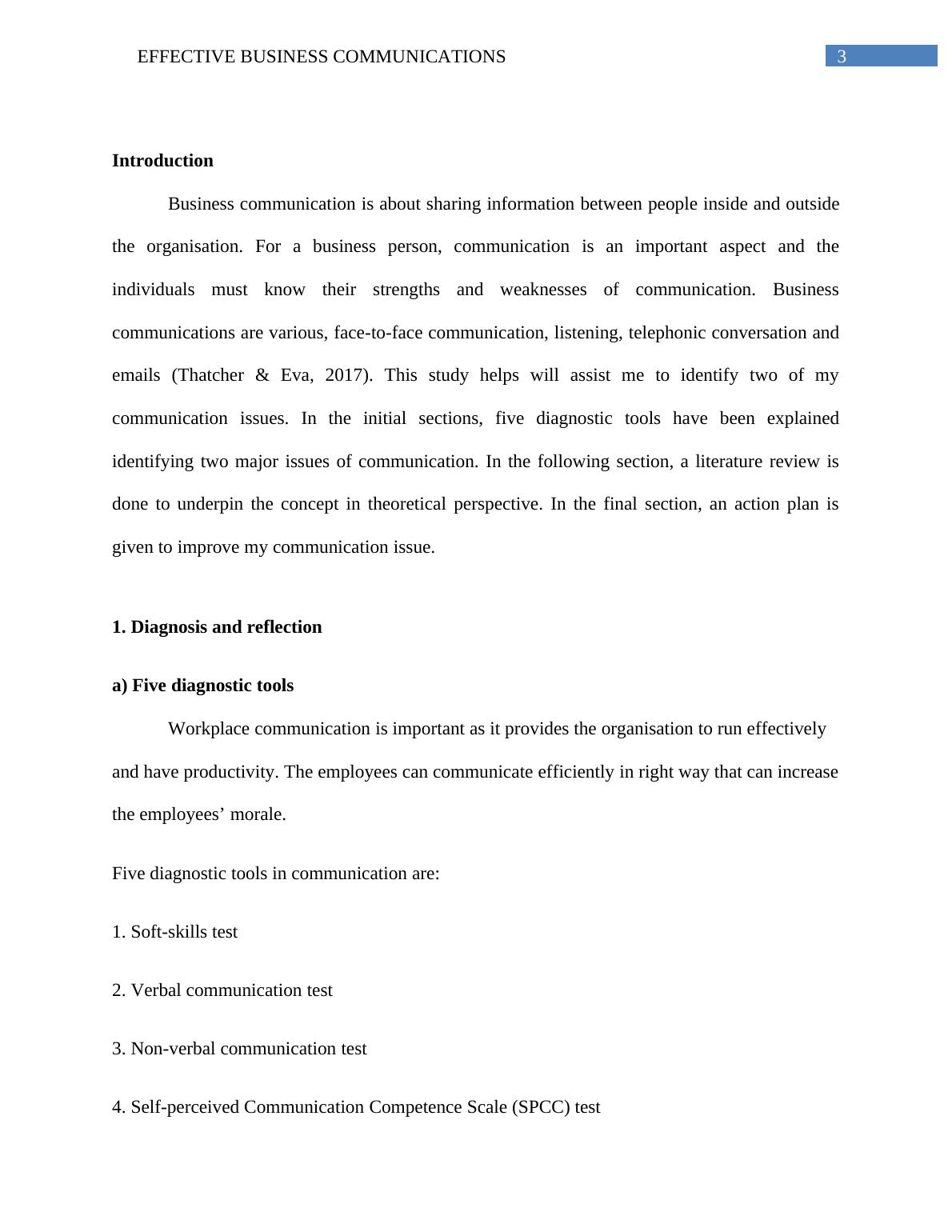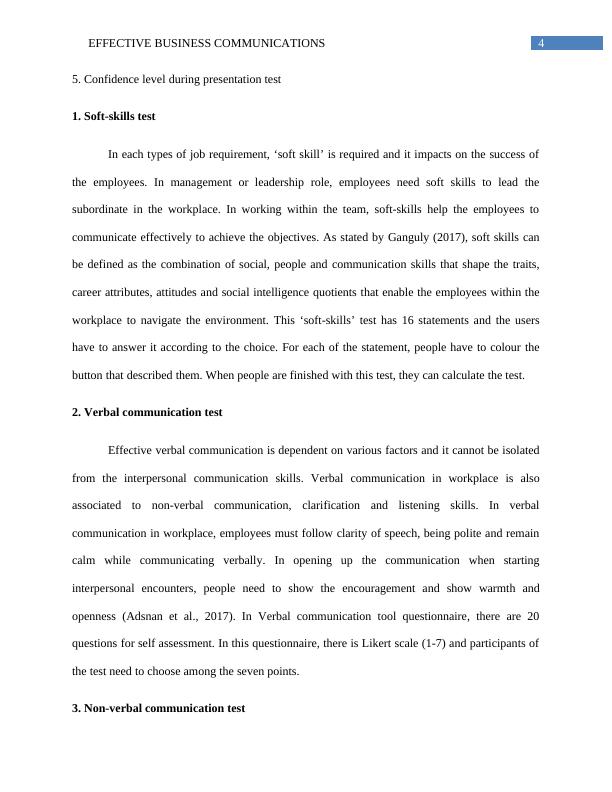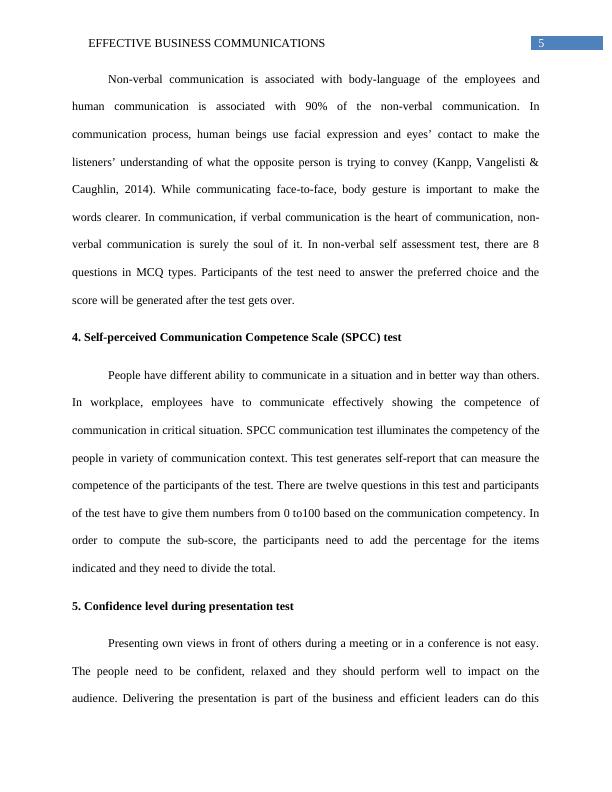Diagnosis and reflection in effective business communications
27 Pages4518 Words35 Views
Added on 2020-05-16
About This Document
Diagnosis and reflection 2 a) Five diagnostic tools 2 b) Findings of the tools 5 c) Two communication issues 7 d) Reflect on two recent professional interactions 7 2. Literature review 8 a) Two issues in communication 8 b) Communication perspective of communication 9 c) Models of communication 10 d) Interpersonal behaviour theory 12 3. Action plan 13 a) Short courses to improve communication 13 b) Reading plan 14 c) Maintaining personal journal 14 d) Identification of mentor 14 Timeline of action plan
Diagnosis and reflection in effective business communications
Added on 2020-05-16
ShareRelated Documents
Running head: EFFECTIVE BUSINESS COMMUNICATIONSEffective Business CommunicationsStudent’s name: Name of the university:Author’s note:

1EFFECTIVE BUSINESS COMMUNICATIONSTable of ContentsIntroduction......................................................................................................................................21. Diagnosis and reflection..............................................................................................................2a) Five diagnostic tools................................................................................................................2b) Findings of the tools................................................................................................................5c) Two communication issues.....................................................................................................7d) Reflect on two recent professional interactions......................................................................72. Literature review..........................................................................................................................8a) Two issues in communication.................................................................................................8b) Theoretical perspective of communication.............................................................................9c) Models of communication.....................................................................................................10d) Interpersonal behaviour theory..............................................................................................123. Action plan.................................................................................................................................13a) Short courses to improve communication.............................................................................13b) Reading plan..........................................................................................................................14c) Maintaining personal journal.................................................................................................14d) Identification of mentor.........................................................................................................14Timeline of action plan..............................................................................................................15Conclusion.....................................................................................................................................16

2EFFECTIVE BUSINESS COMMUNICATIONSReference List................................................................................................................................17Appendices....................................................................................................................................19

3EFFECTIVE BUSINESS COMMUNICATIONSIntroduction Business communication is about sharing information between people inside and outsidethe organisation. For a business person, communication is an important aspect and theindividuals must know their strengths and weaknesses of communication. Businesscommunications are various, face-to-face communication, listening, telephonic conversation andemails (Thatcher & Eva, 2017). This study helps will assist me to identify two of mycommunication issues. In the initial sections, five diagnostic tools have been explainedidentifying two major issues of communication. In the following section, a literature review isdone to underpin the concept in theoretical perspective. In the final section, an action plan isgiven to improve my communication issue. 1. Diagnosis and reflection a) Five diagnostic toolsWorkplace communication is important as it provides the organisation to run effectively and have productivity. The employees can communicate efficiently in right way that can increasethe employees’ morale.Five diagnostic tools in communication are: 1. Soft-skills test2. Verbal communication test3. Non-verbal communication test4. Self-perceived Communication Competence Scale (SPCC) test

4EFFECTIVE BUSINESS COMMUNICATIONS5. Confidence level during presentation test1. Soft-skills testIn each types of job requirement, ‘soft skill’ is required and it impacts on the success ofthe employees. In management or leadership role, employees need soft skills to lead thesubordinate in the workplace. In working within the team, soft-skills help the employees tocommunicate effectively to achieve the objectives. As stated by Ganguly (2017), soft skills canbe defined as the combination of social, people and communication skills that shape the traits,career attributes, attitudes and social intelligence quotients that enable the employees within theworkplace to navigate the environment. This ‘soft-skills’ test has 16 statements and the usershave to answer it according to the choice. For each of the statement, people have to colour thebutton that described them. When people are finished with this test, they can calculate the test. 2. Verbal communication testEffective verbal communication is dependent on various factors and it cannot be isolatedfrom the interpersonal communication skills. Verbal communication in workplace is alsoassociated to non-verbal communication, clarification and listening skills. In verbalcommunication in workplace, employees must follow clarity of speech, being polite and remaincalm while communicating verbally. In opening up the communication when startinginterpersonal encounters, people need to show the encouragement and show warmth andopenness (Adsnan et al., 2017). In Verbal communication tool questionnaire, there are 20questions for self assessment. In this questionnaire, there is Likert scale (1-7) and participants ofthe test need to choose among the seven points. 3. Non-verbal communication test

5EFFECTIVE BUSINESS COMMUNICATIONSNon-verbal communication is associated with body-language of the employees andhuman communication is associated with 90% of the non-verbal communication. Incommunication process, human beings use facial expression and eyes’ contact to make thelisteners’ understanding of what the opposite person is trying to convey (Kanpp, Vangelisti &Caughlin, 2014). While communicating face-to-face, body gesture is important to make thewords clearer. In communication, if verbal communication is the heart of communication, non-verbal communication is surely the soul of it. In non-verbal self assessment test, there are 8questions in MCQ types. Participants of the test need to answer the preferred choice and thescore will be generated after the test gets over. 4. Self-perceived Communication Competence Scale (SPCC) testPeople have different ability to communicate in a situation and in better way than others.In workplace, employees have to communicate effectively showing the competence ofcommunication in critical situation. SPCC communication test illuminates the competency of thepeople in variety of communication context. This test generates self-report that can measure thecompetence of the participants of the test. There are twelve questions in this test and participantsof the test have to give them numbers from 0 to100 based on the communication competency. Inorder to compute the sub-score, the participants need to add the percentage for the itemsindicated and they need to divide the total. 5. Confidence level during presentation testPresenting own views in front of others during a meeting or in a conference is not easy.The people need to be confident, relaxed and they should perform well to impact on theaudience. Delivering the presentation is part of the business and efficient leaders can do this

End of preview
Want to access all the pages? Upload your documents or become a member.
Related Documents
Diagnosis and Reflection Effective Business Communicationlg...
|28
|5031
|220
Effective Business Communications - Assignmentlg...
|24
|4786
|58
Study on Effective Business Communicationlg...
|23
|3749
|25
Interpersonal Communication - Assignmentlg...
|21
|5159
|349
Communication Skills in Workplace Assignmentlg...
|17
|4316
|233
Communication Assignment: Communicating Methodslg...
|23
|5393
|112
